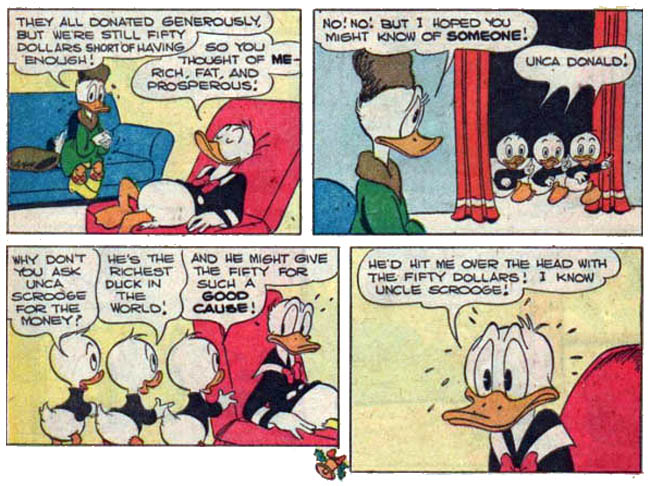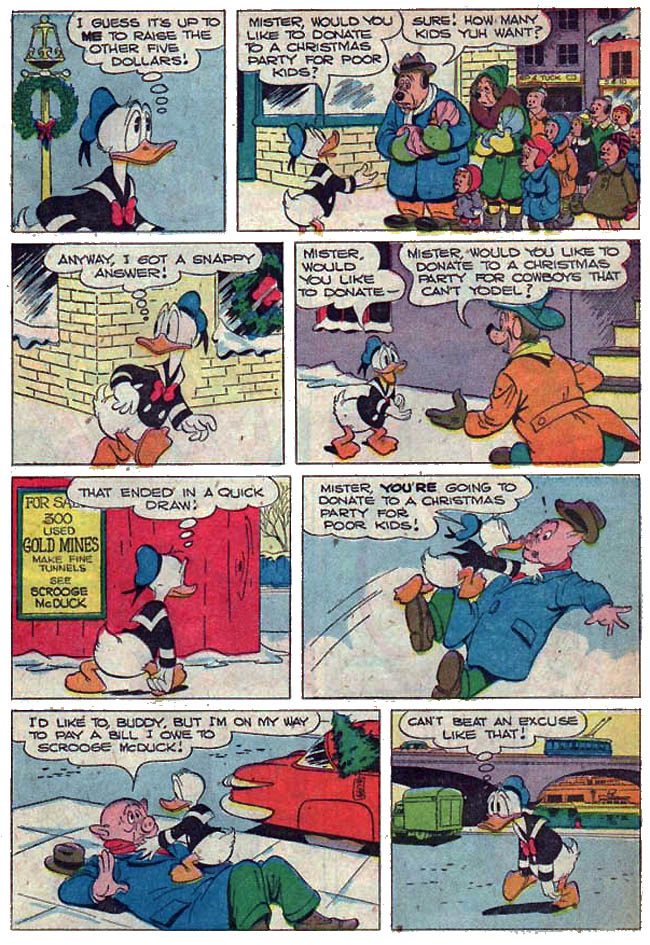Or -“In Which Life Is, Indeed, Somewhat Like A Hurricane…”
Y’know, I’m breaking my carefully planned and meticulously balanced Retro Review schedule to do today’s review, but what the heck? It’s the holidays!
(And besides, pretty much all the Faithful Spoilerites are all too aware that I am far from meticulous nor all that much of a planner…)
 DELL FOUR-COLOR #367
DELL FOUR-COLOR #367
Writer: Carl Barks
Penciler: Carl Barks
Inker: Carl Barks
Colorist: Western Publishing Production Shop
Letterer: Carl Barks
Editor: Alice Neilson Cobb
Publisher: Dell Comics/Western Publishing
Cover Price: 10 Cents
Current Near-Mint Pricing:$360
Previously, in Dell Four-Color Comics: In my duties here at Major Spoilers as Contributing Editor Emeritus, Unofficial Comics “Historian”, Color Commentator, Bottle Washer, Boy Genius & Casual Hero, I often find myself in awe (and jealousy, to be honest) of the creators who make the things we watch, read and love. I would love to write like an Alan Moore, to draw like a George Perez or Wally Wood, to be able to color like Laura Martin or create the tiny typographical miracles that Todd Klein does with his letters. Heck, I’d even enjoy an editor’s job, whatever that is. But there are very few men whose abilities and output I admire more than the man responsible for this week’s Retro Review. As writer, penciler, inker, letterer and creator (of Duckburg, Gladstone Gander, Unca Scrooge & The Junior Woodchucks, just as a start), Carl Barks put a stamp on Donald Duck’s world the way very few men not named Disney were able to. For the better part of 30 years, Barks worked for Disney, and even though his pages weren’t signed or in any way credited (very few were back in the day), readers knew his work and recognized him as “The Good Duck Artist.” This issue is widely considered one of his very finest, as we join Huey, Louie and Dewey on their walk back home…

First page, first panel and Barks has already blown me away… The facial expression on the “woman” in the foreground is simply heartbreaking, and the amount of detail that he’s put into this shantytown is stunning. (Notice the little girl making her ‘snow-duck.’) I’m interested to see that most of the down-on-their-luck residents aren’t ducks (though I can’t be entirely sure what they ARE. Hamsters, maybe?), which part of me suspects was an intentional point on the writer’s part. Someone smarter than me can probably author a treatise on Disney comics’ species discrimination… Either way, as the boys find themselves troubled by the plight of Shacktown’s kids, they bump into their Uncle Donald’s main squeeze, Daisy, who asks what’s got the Junior Woodchucks so down…

The real joy of Barks’ duck stories is that these tales would work with a non-cartoon avian cast as well, and the richness of his world shows again as Daisy sets off to rally the local chapter of the DAR (Ducklings of The American Revolution, which I feel the need to explain I just totally made up, as it’s not a Carl-Barks-worthy joke) around the needy children of Shacktown. Hilariously, she turns to the LEAST likely suspect for assistance…

…or DOES she? If you look closely at Daisy’s big sad-eyed duckface in panel two, you realize that she knew exactly what she was doing in coming to Donald, with her “I hoped you might know of SOMEONE.” Daisy was ready to manipulate Donald into tapping his rich uncle’s wallet! It’s a very subtle moment, but I can’t help but believe it to be intentional. Donald has been worrying about how to pay for his own Christmas for the boys, having only five bucks to his name, but when Daisy, Huey, Dewey & Louie quadruple up on the emotional blackmail, Donald agrees to visit Scrooge McDuck’s mansion and beg for cash. In a moment that truly cracks me up, he immediately plays it tough and tries to threaten the old man, but quickly wilts under the assault of his meaner, smarter Uncle. Donald tries to ply the old miser with sentiment, but that works just about as well as coercion…

I love the bit of business with the Money Bin door and the breaking broom there, a comedic undertone for a sequence heavy in dialogue, without undermining the drama in Donald’s uncomfortable plea for help. And though Uncle Scrooge’s help will assist with funding a Christmas party, there’s just one caveat: He won’t pony up his 25 dollars until Donald gathers and SHOWS HIM the other 25. Of course, anybody who knows a Christmas tale will know that the old man’s disdain for toys will come back around in karmic fashion soon enough, but Donald is game to help the young’ns. With half the fifty bucks theoretically gathered, Donald, Daisy and the boys give up their own Christmas budgets, but still only come up with 20 dollars. Donald Duck takes to the streets to see if the citizens of Duckburg are willing to pitch in…

Okay, so that guy is a pig, and the big family in panel two seems to be dogs. I still have no idea how this world works, given that the poor debtor in the second-to-last panel is also three times Donald’s size. What are the public restrooms in Duckburg like? Am I overthinking this? With his appeal to the public having failed, Donald tries to scam Scrooge out of the money, but his every idea fails miserably, in differeing hilarious ways. It’s truly astonishing to see just how many gags Barks packs this book with, as Donald tries three different tricks in the space of about four pages of story. Each page is fascinating, as Donald earns, then loses, then earns the money again. With a little help from Gladstone Gander (a pretty clever sequence involving a snowdrift, a lost wallet and Gladdy’s legendary luck), Donald and company raise their half of the fifty bucks (although Gladstone murmurs an ominous warning about his good luck turning bad for Donald.) Returning to Uncle Scrooge, Donald requests that the old codger cough up some dough, but his shocked Uncle can only babble that he’s flat-broke!

It seems that Gladstone’s warnings of ill-tiding were worth heeding, as a dime that Donald gave to Scrooge caused the whole Money Bin to collapse inward on itself, dropping Scrooge’s entire fortune into the depths beneath Duckburg! Donald vows that the children of Shacktown are going to get their Christmas, but even the best engineers that money can buy can’t retrieve the McDuck fortune from where it has fallen…

The engineers advise Scrooge that his money is gone, and he’d best just forget it, but even their degrees and fancy-schmancy schooling aren’t a match for the Junior Woodchuck handbooks! Huey, Louie & Dewey remember spelunking a particular cave beneath Shacktown the previous summer, and lead their emotionally-damaged uncles (one in dire need of anger management, one crippled by his hoarder mentality) down into a subterranean maze. (Where in the world is Duckburg located again?) The cave leads them straight to the pit with the money, but there’s only a tiny badger hole to get through. Knowing that they can’t dig or use heavy tools for fear of collapse, all seems lost…
…until H, D & L put their heads together.

Karma time! The very toy train that Scrooge poo-poohed at the beginning of our tale (or at least one very much like it) is the only device both small and steady enough to get into the cave where the cash is resting. But there’s still the matter of a Christmas party to be had, and it’s crafty-but-short-fused Donald who throws down the gauntlet that will bring our story full-circle…

But, though he is a tight-fisted and greedy duck, Scrooge is a tight-fisted and greedy duck of his word, and he donates the promised HUNDRED THOUSAND DOLLARS to the denizens of Shacktown to buy the biggest Christmas ever, replete with dozens of toy trains and enough turkey to feed an army. Interestingly, that amount of money could easily have made their lives better in dozens of ways, but even in the cartoonish land of Duckburg, things aren’t that easy. The people of Shacktown still live in their shanties, shunned and ignored by the rest of the city, and it’s believed that Barks left their fates open to remind us of the reality that Shacktown ISN’T just a cartoon story. Even after Christmas, the poor folk will still be there, possibly in need of more than just a toy train. It’s a very successful story, even decades after it was printed, and the final joke (with Scrooge refusing to leave the cave and estimating that it will take more than 200 years to get his cash back) is a scream, and I’m amazed again at how much emotion the artist gets out of his orange-billed cast. This story is not just a holiday classic, but a comic book gem as well, combining a strong story, a little adventure, some holiday cheer and a tiny bit of social commentary into one whole. Dell Four-Color Comics #367 is a tale so fine that anything less than 5 out of 5 stars overall would cause the entire star rating system to collapse in on itself in disgust.
Faithful Spoilerite Holiday Greeting Of The Day: Whatever y’all celebrate (or don’t celebrate, as the case may be), here’s hoping that it’s a good one, and your new year prosperous. And as Torq would undoubtedly say, “Keep your barnacles clear, ‘r som’pin…”




1 Comment
We’re in complete agreement on this one. Carl Barks hit one out of the ball park with this one. I read this one when I was a kid. Carl Barks grew up near Klamath Falls, where I live, and the Klamath County museum has a small display case with some Carl Barks books and illustrations in it. Sadly, I was never able to meet the man in person. Just west of Klamath Falls is the Running Y Ranch Resort. This ranch used to be owned by Walt Disney, who would come up here to fish and relax, and I have always suspected that Carl Barks probably introduced Walt to the region. I have seen people pull world’s record rainbow trout of Upper Klamath Lake and the Williamson River, but the lake is so full of algae that I wouldn’t care to eat anything that came out of the lake. Disney’s house at the ranch still exists, the Running Y uses it to house visiting VIPs.